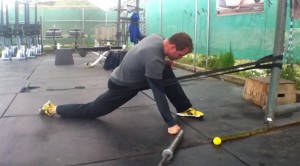Why Your Body is Broken (and How to Start Fixing It)
Your body is broken. Yes, you. And the worst part is? You probably don't even realize it.
Like the vast majority of people, you don't realize your body is dangling in a precarious state of pseudo-dysfunction – until it's too late. You work out a few times a week, try to eat healthy, and avoid intravenous drugs. All said, you probably think you're pretty healthy. Until you throw out your back picking up a sack of groceries. Or you mangle your shoulder playing a game of catch. Or, as a friend recently told me, it's all fun and games until your f*@&ing achilles tendon snaps (!) while you're dancing in the kitchen.
This is not natural, but more and more, it's becoming normal. Kids tearing their ACL on the playground? That pain in your knees/shoulders/elbows/back/whatever else is hurting when you move? Those aren't natural, either.
Your body is designed to go through millions of movement cycles, over and over again, with relatively little wear and tear. You out-evolved the saber-toothed tiger and the wooly mammoth, for God's sake? How did your perfectly engineered body ever become so broken?
What your body was designed for (vs. how you use it)
For the majority of human existence, life has been pretty physically challenging. Walking or hiking all day, kneeling down to pick and dig for berries, nuts, and shrubs. Hunting animals five times your size. Lifting heavy rocks to create shelter so the neighboring tribe doesn't bludgeon you over the head in the middle of the night with a 40 pound club. That sort of thing.
In this little paleolithic picture, there are no chairs in sight. No laptops, and certainly no smartphones. Consequently, there are no hunched over humans sitting at a desk, rolling their shoulders inwards and deactivating their glutes. And for the most part, this is a very good thing. You see, without rehashing the entire “sitting is worse than smoking” argument, you have to come to terms with the fact that that the way the average, modern human uses his or her body is sub-optimal. The second you sit down, your glutes (the largest muscles in the body) shut down completely. No more calorie-burning tension, no more erect posture, and no more blood flow. Furthermore, you're completely sedentary for most of your life, and are faced with a never-ending supply of easy calories. And that's just the beginning, because you spend the vast majority of your day (and evening) in this folded position, and your body will adjust to it by tightening your hips and other muscles. Oh, and guess what? Your daily run also makes a lot of your leg muscles tight! In time, these various forms of tightness cause a whole host of other issues – but we'll get to that.
Your exercise may be doing more harm than help

Squatting with proper technique not only gives you a perfectly sculpted bottom half – it's also very effective treatment for all sorts of knee, ankle, and hip issues. Stop making excuses and do your damn squats.
I began lifting weights seriously (4-5 times a week with the supervision of a “qualified” coach) at the age of 14 years old. I was athletic, played sports, and looked fit and healthy. But for as long as I can remember, I've had knee pain, shoulder pain, weakness in certain movements, and lots of other joint-related issues. How can this be?
It wasn't until I happened upon Clayton Cornell's excellent post (on a travel blog, of all places), entitled “How I Broke my Body and Then Fixed It,” that I started to understand the causes of my pain and dysfunction. That article, as you've probably surmised, is the inspiration for this one. It's quite long, but worth a skim if you're interested in a real-life mobility success story.
Like me, Clayton was a very active guy, but still suffered from a ton of joint and muscle issues. Western medicine such as Physical Therapy and cortisone injections failed us both. Ultimately, we both had to come to the same conclusion; we had caused these problems with improper movement patterns.
Now, I could (and likely will, in a future article) go on about the perils of using fixed-axis gym equipment, isolating muscles, and doing unnatural movements in place of functional ones (you're not a bird – why are you doing chest flies?). I could also go on and on about how a weightlifting regimen shortens and tightens muscles, which can cause tremendous dysfunction, pain, and misery unless paired with a proper mobility routine far beyond your typical 2 minute stretching routing. The reality is, though, that the workouts are just the tip of the iceberg.
Learning How to Move
It may come to you as a surprise that there's a proper way to sit on the toilet, stand up in the morning, lift a grocery bag, or squat to pick up your dropped keys. But the very fact that this is a surprise is why your body is broken. You likely don't know how to use it.
Like Clayton, I needed to learn how to move properly. I needed to learn how to squat in such a way that protected my knees – the same movement as getting up from the chair. I had to learn how to use my abdominal and gluteus muscles to brace, support, and organize my spine, whether seated or standing. All of this sounds like it would be basic knowledge, but let me ask you this; as you sit there, reading along, are your abs at 20% tension, supporting your spine and maintaining proper posture so you can breathe properly? I think we both know the answer.
Once you notice one dysfunction in your body, you'll start noticing many, many more. It's all interconnected, and you'll start realizing that things like the outward angle of your feet when you walk, the pinching in your lower spine, and the numbness in your calves are all symptoms of a body in distress. It's all connected. Stay with me now. This is where we begin to see some light.
It wasn't until I found Clayton's article that I learned about an entirely different field of exercise and fitness, which we'll call Mobility. This field is championed by a number of experts from Ido Portal to Pete Egoscue, but perhaps none of them is as noteworthy as Kelly Starrett. The man fixes everyone from Navy Seals and fighter pilots to Olympic athletes and Fortune 500 CEOs. After reading Clayton's experience working with KStar himself, I picked up Kelly's bookshelf-breaking Becoming a Supple Leopard and started re-learning how to sit, squat, stand, and even walk. I was already feeling a difference, but now it was time for some productive pain.
What the F*@& is a Fascia and Why Should You Care?
Have you ever removed the skin from a chicken breast? Did you notice that slimy, clear membrane between the skin and the breast? That's a fascia. You have various types of them throughout your body, and one of their primary functions is to ensure that your muscles move smoothly and stably without friction or interference from your skin, bones, organs, etc. They also contain a ton of nerves, signaling to your brain whether or not your muscles are functioning healthily.

Your standard stretches suck. KStar shows you how to make them worth a damn by Tacking & Flossing.
In the interest of keeping this article of reasonable length, I won't go into too much detail about fasciae and their function. What I will say is this; both training your muscles and abusing them by sitting all day will eventually cause muscle dysfunction. From time to time, muscles become knotted, matted, stuck together and just generally screwed up. If the fasciae ain't happy, the muscles ain't happy. However, only in recent years has sports medicine begun to widely accept that stretching does very little to help this unhappiness. In fact, it may exacerbate the problem; I love Kelly's analogy of a rubber brand that's thicker on one end. If you stretch that rubber band without special tools to isolate the thick end, you're just weakening it at the thin end. Anyways, stretching does very little to unglue matted, knotted tissue in the best-case scenario.
Restoring regular muscle function and movement is crucial not just for the functioning of the muscles, but also to prevent transference of the problem to other places in the body. I, for example, am overcoming knee pain caused by tightness in my hips and inner glutes, and have had to deal with spasms and “charlie horses” in my upper back that originate from tightness in my quadriceps and abdominals – on the opposite side of my body. Imagine my surprise when massages and stretching failed to stop the seizing muscles. Like I said, it's all connected, and for this reason, a number of practices for myofascial release (or the practice of breaking up knotted muscle tissue or fibrosis) have become popular. They include:
- Active Release Therapy: Advocated by Tim Ferriss for restoring joint motion, this is where a trained specialist digs their fingers or other instruments of torture into tissues that are matted or dysfunctional, thereby restoring proper mobility. It hurts like hell. But it works really well. I personally subject myself to A.R.T. at least once a month, and often more.
- Foam Rolling: Whether rolling on a foam roller, a lacrosse ball, or a barbell, rolling works by smashing and releasing the tissues, similar to A.R.T. It also hurts like hell, but allows you to go at your own pace and “feel around” for the dysfunction. There is a right and a wrong way to do it, but it's virtually impossible to injure yourself doing this. I suggest it as a great beginner's tool, and I love Dr. Mark Cheng's introduction video linked above.
- Banded Stretching / Tack & Floss: One of the more powerful techniques developed in the “lab” by Kelly Starrett, this involves “tacking” a portion of your muscle to limit where the motion and stretch come from (remember the rubber band analogy?) and then taking it through a stretched range of motion (see the photo above). It's another great tool to add to your tool kit, but is a bit more advanced and should be used with caution. Check out the video linked, it's one of the many MobilityWOD videos you can view for free.
- Voodoo Banding: Another Kelly Starrett innovation, this is where you compress the tissues and mash them together using what's basically a tourniquet, and then force them through the range of motion. Perhaps the most powerful and instant tool in the tool kit, it fires all kinds of nerve signals to the brain, smashes the tissues into their normal function, and hypes up your blood flow all at once. If you don't mind people at the gym asking you if you're about to shoot up, I strongly recommend purchasing some Rogue voodoo floss bands or generic floss bands and giving them a spin.
- Kinesiology Tape: If you've watched the Olympics in recent years, you've seen athletes with blue or black tape in strange patterns around their muscles. This is kino tape, and it's specially designed to “lift” the skin from the muscles to restore function and promote blood flow. A caveat here: kino tape is not a stand-alone tool and won't help without some other form of myofascial release, plus it needs to be applied by a trained professional.
- Muscle Activation Technique: I actually didn't know about this one until a friend recommended I add it, and so it's something I hope to research further. Essentially, MAT seems to be a program aimed at balancing the muscles by activating them selectively. Apparently, Peyton Manning credits MAT with his speedy post-surgery recovery, so it's definitely worth checking out.
Where to Begin
I realize this has been something of a doom and gloom article. Your workouts aren't good enough, you're sitting yourself to death, and you don't even know how to walk right. Gee, thanks. So what now?
Personally, the first step both Clayton and I took was to change out the shitty workout. Bye-bye seated quad extensions and chest flies (which caused the knee and shoulder pain I thought they were ameloriating). I switched to the more well-rounded, functional CrossFit and haven't looked back. I like CrossFit because it's one of the most (though not the only) well-rounded workout programs – meaning that it varies in volume, time, movement patterns, and intensity. It's also a lot safer, despite what many may believe and the media hype over a few rare mishaps. Not only are my movements supervised and critiqued by skilled trainers, but the regimen is designed to prevent muscle imbalances. The movements in CrossFit, such as squats, deadlifts, etc also taught me how to hold and use my body correctly, preventing injury and slowly working away years of muscle imbalances and bad posture. But of course, CrossFit isn't for everybody (Though I have had my ass kicked by a 60-something grandmother at CrossFit Cape Town – seriously). If you're not going to do CrossFit, then find some combination of workout programs that fit you. Don't just run 4x a week – hit up some yoga, TRX, olympic weightlifting (supervision very much required), and gymnastics. It's all about variation and balance – and the main reason I recommend CrossFit is that it takes the thinking out, and has all of that baked into one membership fee and one easy-to-follow program.
Along those lines, I also love that CrossFit comes with a culture of mobility and muscle repair. Every workout ends with a 10-15 minute mobility segment, though that's not nearly enough. Even though I've switched to a standing desk, I still sit a lot, and this means that I have to roll, stretch, floss, and generally abuse my hip flexors and quads a lot, too. Whenever I fail to do my proper mobility regimen, the knee pain starts acting up again, and it's a sign that my hip and quad muscles are out of whack.
Remember that any mobility exercise is a huge improvement over nothing. Simply switching one of your weight training workouts to Yoga every week will help a great deal. But if you want to get serious and start tackling the various areas of dysfunction in your body, I suggest checking out either MobilityWOD or Becoming a Supple Leopard and designing a simple, easy-to-follow routine. There's no way you'll do more than 2-3 exercises a day, but if you manage to do even that, you'll see dramatic improvement in your mobility, and consequently, your strength. You can eliminate pain and prevent injury, and the tools and information are out there. If you want an entertaining and easy-to-digest intro to Kelly's work, I suggest checking out this (semi-drunken) podcast with Tim Ferriss and Dr. Justin Mager. I've also provided a very technical 1-hour workshop video by Kelly below, for those who like to take things to the extreme.
Ultimately, keep your chin up and start gradually working towards a fix, armed with some of the information and resources linked above. Remember that things could be a lot worse. After all, we haven't even started talking about your diet.


No Comment